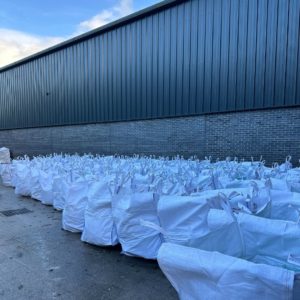We are proud to announce our participation in the Glass Forever Cullet Return Programme by Saint-Gobain Glass.
Developed in answer to Saint-Gobain’s Net Zero 2050 target, Glass Forever is a circular economy approach to sustainability, sourcing waste glass, otherwise known as cullet and remanufacturing it into new, high-performing glass.
As one of the UK’s leading glass manufacturers, it’s important that we do everything we can at SGP to reduce our carbon footprint, NOX emissions, and raw material usage to protect our environment.
Specialist Glass Products has a long-standing relationship with Saint-Gobain Glass. Most recently, we hosted glass curving trials of their new COOL-LITE SKN 183 II solar-control glass at our factory, where we utilised our experience in traditional slump glass bending. We discovered that the energy-efficient glass could be successfully curved, opening a new realm of design possibilities for residential and commercial buildings.
Keep reading to learn more about our involvement with the Glass Forever programme with Saint-Gobain Glass!
Glass Forever cullet return scheme
By remanufacturing glass, Saint-Gobain Glass can reduce the requirement for virgin raw materials, thereby significantly reducing the embodied carbon levels in all new glass produced at their plant in Eggborough, Yorkshire. Beyond resource conservation, this approach champions a sustainable and responsible manufacturing method, providing improved glazing solutions for homeowners and commercial applications.
 As part of our ongoing relationship with Saint-Gobain Glass, we plan to recycle all clear cullet glass from our factory using the Glass Forever programme. We will also continue to invest in innovative new machinery to improve efficiency and reduce the amount of broken glass.
As part of our ongoing relationship with Saint-Gobain Glass, we plan to recycle all clear cullet glass from our factory using the Glass Forever programme. We will also continue to invest in innovative new machinery to improve efficiency and reduce the amount of broken glass.
Glass is infinitely recyclable, and manufacturers can prevent 700kg of CO2 from going into the atmosphere for every tonne of crushed glass that is reused. (This includes scope 1, 2 and 3 emissions) Reusing one tonne of cullet can also save 1.2 tonnes of virgin raw materials from being used; this is vital as the natural resources needed to manufacture glass are in decline.
In addition, one tonne of reused crushed glass can save enough energy to power the average home for six months!
Focused on post-consumer cullet waste, Richard Calcutt, Technical Product Manager at Saint-Gobain Glass, performs thorough site analysis to pinpoint cullet recycling opportunities. He also devises streamlined removal and transportation methods, facilitating the transport of recovered glass to the Eggborough facility for re-manufacturing. “I am committed to optimising cullet recycling potential,” affirms Richard. “This dedication ensures a sustainable life cycle for glass products and aligns with Saint-Gobain Glass’s pledge to environmental responsibility in the construction sector.”
The environmental impact of our glass recycling
Through our commitment to recycling cullet glass, we have contributed towards significant energy savings that will positively impact the environment.
Last year alone, we returned 1,365 bags of cullet glass through the scheme in 2023, which equals 775 tonnes (the same weight as 51 double-decker buses!). On average, we recycled 46.8 tonnes and 82.6 bags of cullet glass each month.
Recycling this weight of cullet into the Glass Forever scheme prevented 542 tonnes of CO2 from polluting the atmosphere and saved enough energy to power an average home for 387 years. For reference, two tonnes of cullet saves sufficient energy to power the average home for one year!
This year, we plan to recycle the same amount of cullet glass, if not more, to continue doing our part to reduce the reliance on raw materials and overall CO2 emissions in the glass industry.
The importance of using recycled glass in Net-Zero buildings
Net-zero buildings are designed to achieve an energy balance by producing as much energy as they consume, minimising energy usage, and promoting renewable energy sources.
Constructing net-zero carbon buildings will be a big focus for construction firms moving forward. Official legislation states that the UK government has committed to a legally binding target of bringing carbon emissions to net zero by 2050.
Sourcing sustainable building materials, such as recycled glass, can lessen the carbon emissions of the entire construction process. In addition, supporting recycling schemes that lower carbon emissions in the construction industry will help to promote a net zero construction process.
Types of glass that can contribute to sustainable buildings
There are specific types of glass designed to create a sustainable building, including:
- Double-glazed units – Double-glazing can be defined by two window panes separated by a vacuum to reduce heat transfer, suitable for insulated windows to keep heat in.
- Low-E (Low Emissivity) Glass – Glass is optimised with a Low-E coating to reduce infrared and ultraviolet rays passing through it, improving insulation for the building.
- Thermochromic Glass – This type of glass automatically changes its opacity in response to sunlight entering the building, effectively keeping the room cooler in summer and preventing heat loss in winter.
- Electrochromic Glass – Glass that can be tinted, using manual electric controls, to control the amount of light passing through it, helping to reduce the need for heating and air conditioning year-round.
The above examples of glass are beneficial when developing a green building. Green buildings are defined as structures that prioritise energy-efficient features, for example, using local materials to reduce transportation costs, adding low water flow facilities to reduce water wastage, solar energy aspects such as solar roof panels and energy-control glass to minimise energy loss through the exterior of the building.
We recently discovered the top ten UK areas with the highest number of green buildings and found that Manchester, Cambridge and Bristol came out on top.
If you are interested in using sustainable glass in your next eco-friendly building project but are still deciding about the best choice, please get in touch, and our team will be happy to consult with you.
Examples of glass features to maximise natural light
Glass features should be thoughtfully implemented in building design to allow daylight to enter, as this can lower the need for electric lightbulbs and promote energy efficiency to reduce the reliance on heating sources.
Various types of glass features are suitable for commercial buildings, including glass partitions, which can create an aesthetically pleasing room design while maintaining sound privacy when combined with acoustic glass. For head office entranceways, glass staircases and doors create a contemporary and professional look to the building while allowing natural light to flood in, reducing the reliance on electric lighting.
For residential building design, architectural and construction companies can use internal and external glass doors to open up smaller rooms while creating a sought-after indoor-outdoor feel to the home. Glass skylights are a fantastic addition to kitchen-diner extensions to maximise the natural light and provide additional ventilation options in warmer months.
The placement of your building’s glass features should also consider whether each room is south-facing or north-facing to maximise the light flooding in. For example, south-facing rooms will see the most hours of sunlight during the day, so it would be great for a home office, whereas north-facing rooms tend to be shadier with a more consistent lighting temperature are more suited for an art studio.
Glass balustrading in gardens is an excellent choice for residential properties as they help make the most of outdoor areas and, when built with toughened glass, can withstand temperature fluctuations.
Other benefits of using glass in buildings
In commercial buildings, glass features are highly beneficial as the additional natural light boosts employee productivity and well-being. Recent studies reveal that UK employees believe exposure to natural light in the office boosts their creativity.
Promoting natural light and sustainability in residential buildings can increase the property’s value as homeowners desire an energy-efficient home to lower their energy bills. Glass features can also improve the perceived size of the home and create an airy feel to a property.
Glass is also an extremely adaptable building material for all property types. For example, property builders can choose tinted glass for added privacy in conservatories and glass partitions or opt for coloured glass to create a stand-out architectural feature.
How SGP can support your next project
At Specialist Glass Products, we manufacture a range of glass products, from structural glass, curved glass and oversized jumbo glass units. Our wide range of state-of-the-art machinery allows us to cut, toughen and laminate glass up to 6000mm x 3210mm.
Get in touch with our friendly team to discuss your custom requirements, and let us help you find the perfect type of glass for your sustainable building design.



